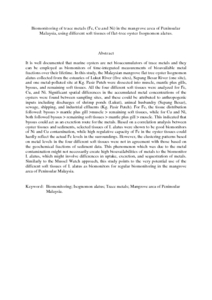Citation
Yap, Chee Kong and Azmizan, A. R. and Hanif, M. S.
(2011)
Biomonitoring of trace metals (Fe, Cu and Ni) in the mangrove area of Peninsular Malaysia, using different soft tissues of flat-tree oyster Isognomon alatus.
Water, Air and Soil Pollution, 218 (1).
pp. 19-36.
ISSN 0049-6979
Abstract
It is well documented that marine oysters are net bioaccumulators of trace metals and they can be employed as biomonitors of time-integrated measurements of bioavailable metal fractions over their lifetime. In this study, the Malaysian mangrove flat tree oyster Isognomon alatus collected from the estuaries of Lukut River (five sites), Sepang Besar River (one site), and one metal-polluted site at Kg. Pasir Puteh were dissected into muscle, mantle plus gills, byssus, and remaining soft tissues. All the four different soft tissues were analyzed for Fe, Cu, and Ni. Significant spatial differences in the accumulated metal concentrations of the oysters were found between sampling sites, and these could be attributed to anthropogenic inputs including discharges of shrimp ponds (Lukut), animal husbandry (Sepang Besar), sewage, shipping, and industrial effluents (Kg. Pasir Puteh). For Fe, the tissue distribution followed: byssus > mantle plus gill >muscle > remaining soft tissues, while for Cu and Ni, both followed byssus > remaining soft tissues > mantle plus gill > muscle. This indicated that byssus could act as an excretion route for the metals. Based on a correlation analysis between oyster tissues and sediments, selected tissues of I. alatus were shown to be good biomonitors of Ni and Cu contamination, while high regulative capacity of Fe in the oyster tissues could hardly reflect the actual Fe levels in the surroundings. However, the clustering patterns based on metal levels in the four different soft tissues were not in agreement with those based on the geochemical fractions of sediment data. This phenomenon which was due to the metal contamination might not necessarily create high bioavailabilities of metals to the biomonitor I. alatus, which might involve differences in uptake, excretion, and sequestration of metals. Similarly to the Mussel Watch approach, this study points to the very potential use of the different soft tissues of I. alatus as biomonitors for regular biomonitoring in the mangrove area of Peninsular Malaysia.
Download File
![[img]](http://psasir.upm.edu.my/24824/1.hassmallThumbnailVersion/Biomonitoring%20of%20trace%20metals%20%28Fe%2C%20Cu%20and%20Ni%29%20in%20the%20mangrove%20area%20of%20Peninsular%20Malaysia%2C%20using%20different%20soft%20tissues%20of%20flat-tree%20oyster%20Isognomon%20alatus..pdf)  Preview |
|
PDF (Abstract)
Biomonitoring of trace metals (Fe, Cu and Ni) in the mangrove area of Peninsular Malaysia, using different soft tissues of flat-tree oyster Isognomon alatus..pdf
Download (84kB)
| Preview
|
|
Additional Metadata
Actions (login required)
 |
View Item |

